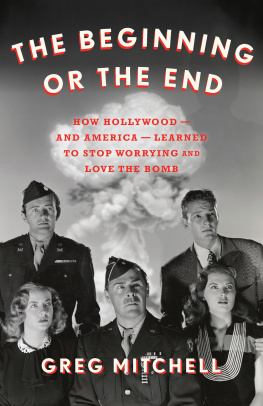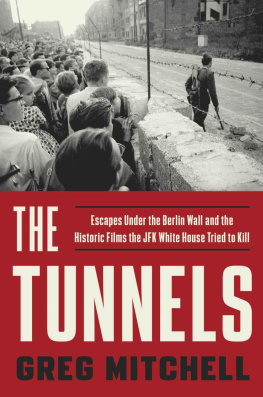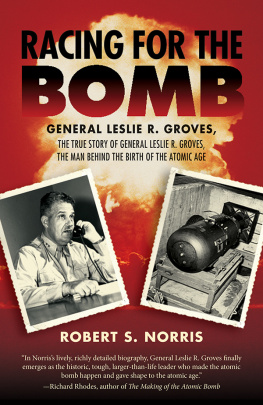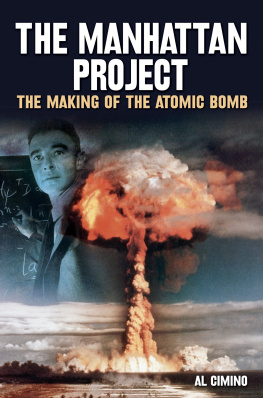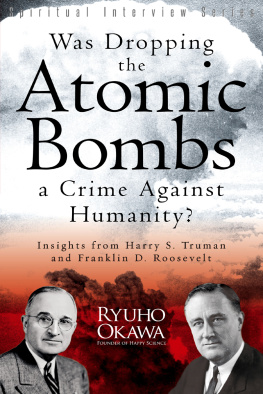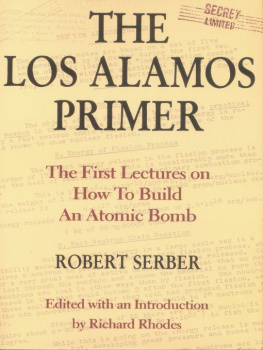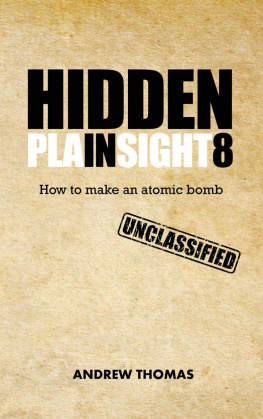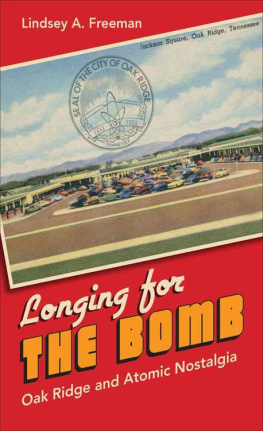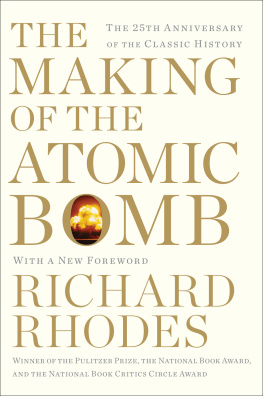
THE BEGINNING OR THE END
Also by Greg Mitchell
The Tunnels
Atomic Cover-Up
So Wrong for So Long
Hiroshima in America (with Robert Jay Lifton)
Tricky Dick and the Pink Lady
The Campaign of the Century
Joy in Mudville
Who Owns Death? (with Robert Jay Lifton)
THE BEGINNING OR THE END
HOW HOLLYWOODAND AMERICALEARNED TO STOP WORRYING AND LOVE THE BOMB
GREG MITCHELL

History is often not what actually happened, but what is recorded as such.
Henry L. Stimson, Secretary of War, 19401945
CONTENTS
CAST OF CHARACTERS
Carter Barron: MGMs representative in Washington, D.C.
Jerome Beatty: Magazine writer who wrote original Top Secret story for Wallis
Roman Bohnen: Character actor, likely Communist, slated to play Truman
Niels Bohr: Top Danish atomic physicist who fled to Sweden
Vannevar Bush: Head of federal office overseeing science work
Al Cohn: Former screenwriter who sold Hal Wallis on atomic bomb movie
James B. Conant: President of Harvard who advised on use of bomb against Japan
Bob Considine: Well-known magazine writer, Hearst columnist, author
W.A. Consodine: Groves aide, military adviser at MGM for movie
Hume Cronyn: Actor picked to play Oppenheimer
Brian Donlevy: Well-known actor who took role of Leslie Groves
Tom Drake: Young actor who played ethical scientist Matt Cochran
Albert Einstein: 1939 letter to FDR alerted him to ability to make atomic bomb, later criticized use of weapon
Enrico Fermi: Led chain reaction experiment in Chicago
General Leslie Groves: Military chief and overall director at Los Alamos
David Hawkins: Former Oppenheimer aide, tech adviser to movie
Walter Lippmann: Nations most renowned opinion columnist
John Lee Mahin: Well-known screenwriter hired by MGM to tweak Wead script
Sam Marx: MGM producer, former story editor for studio
James K. McGuinness: Former MGM screenwriter now exec, right-wing activist
J.J. Nickson: Activist scientist in Chicago
J. Robert Oppenheimer: Father of the Atomic Bomb (wife: Kitty)
Tony Owen: Hollywood agent, husband of Donna Reed
William Deke Parsons: Armed Hiroshima bomb on way to target
Ayn Rand: Novelist and screenwriter for Hal Wallis
Donna Reed: Young actress, former student of Edward Tompkins
Charles Ross: Truman press secretary, former newspaperman
Robert Smith: Screenwriter hired by Wallis to salvage Rand script
Charles Sweeney: Pilot of Nagasaki bomber, adviser to MGM
Leo Szilard: Famed physicist who tried to halt use of bomb against Japan
Norman Taurog: Director of movie whose best films were behind him
Paul Tibbets: Pilot of Enola Gay
Edward Tompkins: Young Oak Ridge scientist, former teacher of Donna Reed
Audrey Totter: Actress who played Grovess secretary Jean OLeary
Robert Walker: Actor who portrayed roguish fictional Groves aide Colonel Jeff Nixon
Hal B. Wallis: Very successful producer, now with Paramount
Frank Spig Wead: Screenwriter, famous for military flying exploits
H.T. Wensel: Physicist picked by Groves to replace Tompkins as tech adviser
A BRIEF CHRONOLOGY (APRIL 1945OCTOBER 1945)
April 12: President Roosevelt dies.
April 25: President Truman is finally told about the bomb project.
May 7: Germany surrenders to the Allies.
Early July: Plans set for use of bomb, Szilard petition protests this.
July 16: Successful test of the first atomic bomb at the Trinity site.
July 26: Potsdam Declaration calls for unconditional surrender of Japan. Truman gets Stalins agreement to attack Japan by mid-August.
August 6: Hiroshima devastated with Little Boy bomb.
August 8: The Soviet Union declares war on Japan.
August 9: Nagasaki attacked with Fat Man bomb.
August 14: Japanese emperor announces surrender.
September 2: Japan formally surrenders as the U.S. occupation begins.
September-October: Thousands of Manhattan Project scientists form associations and call for international control of atomic energy.
October 25: Dr. Edward Tompkins from Oak Ridge writes his former student Donna Reed in Santa Monica.
PREFACE
With its costly drama The Beginning or the End finally completed in early January 1947, including a critical new scene ordered by the White House, MGM dared to screen it for atomic scientists in Chicago. Legendary studio chief Louis B. Mayer had once called it the most important movie he would ever make. Now, after dozens of revisions and deletions ordered by President Harry S. Truman and the military, how would it fare with some of the men who helped create the revolutionary weapon that had been deployed against two Japanese cities seventeen months earlier?
Leo Szilard, who played a key role in developing the bomb and then tried to impede President Truman from using it, attended the preview in the citys Loop with nuclear chemist Harrison Brown, a veteran of the Manhattan Projects top-secret site at Oak Ridge, Tennessee. During the screening, scientists around them erupted in laughter at the broad Italian accent of the actor playing Enrico Fermi, whose atomic chain reaction in Chicago paved the way for creating the new weapon. They chuckled at miscast Hume Cronyns valiant attempts to mimic J. Robert Oppenheimer, the now-famous scientific director at Los Alamos. Then they turned sullen as the pro-bomb message of the film became clear, with General Leslie R. Groves, overall director of the Manhattan Projectplayed by Brian Donlevyportrayed as a dashing hero. The scientists had no clue that the movie studio had secretly granted Groves script approval, which he had fully exercised, and then some.
Harrison Brown found it profoundly disorienting to see so many former colleagues on the silver screen. The factual errors upset him. He considered the tacked-on love story insipid in the extreme. The ear-splitting noise accompanying the Fermi chain reaction sounded like the Walls of Jericho falling; almost as bad were the flashing lights and buzzing bells. He was particularly outraged by repeated references to leaflets being showered over Hiroshima warning of an imminent atomic attack; nothing of the kind occurred. And then the movie didnt even bother to depict the assault on Nagasaki, which he found nauseating. To top it off, the fanciful ending seemed both silly and overly optimistic about a nuclearized future.
As the screen went dark and the lights came up, the MGM representative, in from Hollywood, asked audience members for comments. Nearly all remained silent. Leo Szilard, meanwhile, beat a hasty retreat, slipping out a side door, down an elevator, and out to Browns sedan parked on the street nearby. There Brown would find him crouched on the floor between the front and back seats as if in penitence or afraid to be recognized. If our sin as scientists was to make and use the atomic bomb, Szilard would later admit, then our punishment was to watch The Beginning or the End.
In the following pages, I trace what might be called The Making and Remaking of this would-be Hollywood epic, from its genesis, when it was inspired by the scientists warnings, to the pro-bomb celebrationdictated by the Pentagon and White Housethat it eventually became. There are many wild, unlikely, and entertaining stops along the way (as befits any Inside Hollywood account), but this story also charts an extremely significant turning point. For a moment it appeared that a nuclear arms race and the earth-shattering threat it representedstill very much with us todaymight be slowed, or even stopped in its tracks, only to be refueled by wide-ranging official efforts to shape media coverage and public opinion. Seventy-five years later, this countrys first-strike nuclear policy remains in place. The atomic attacks on Japan continue to be endorsed by most Americans and, by all evidence, the vast majority of those in the media and in key positions in the government (no matter who is president). This can only encourage, or at least enable, a pre-emptive strike by any nuclear power today. A recent survey of three thousand Americans by You Gov and the
Next page
